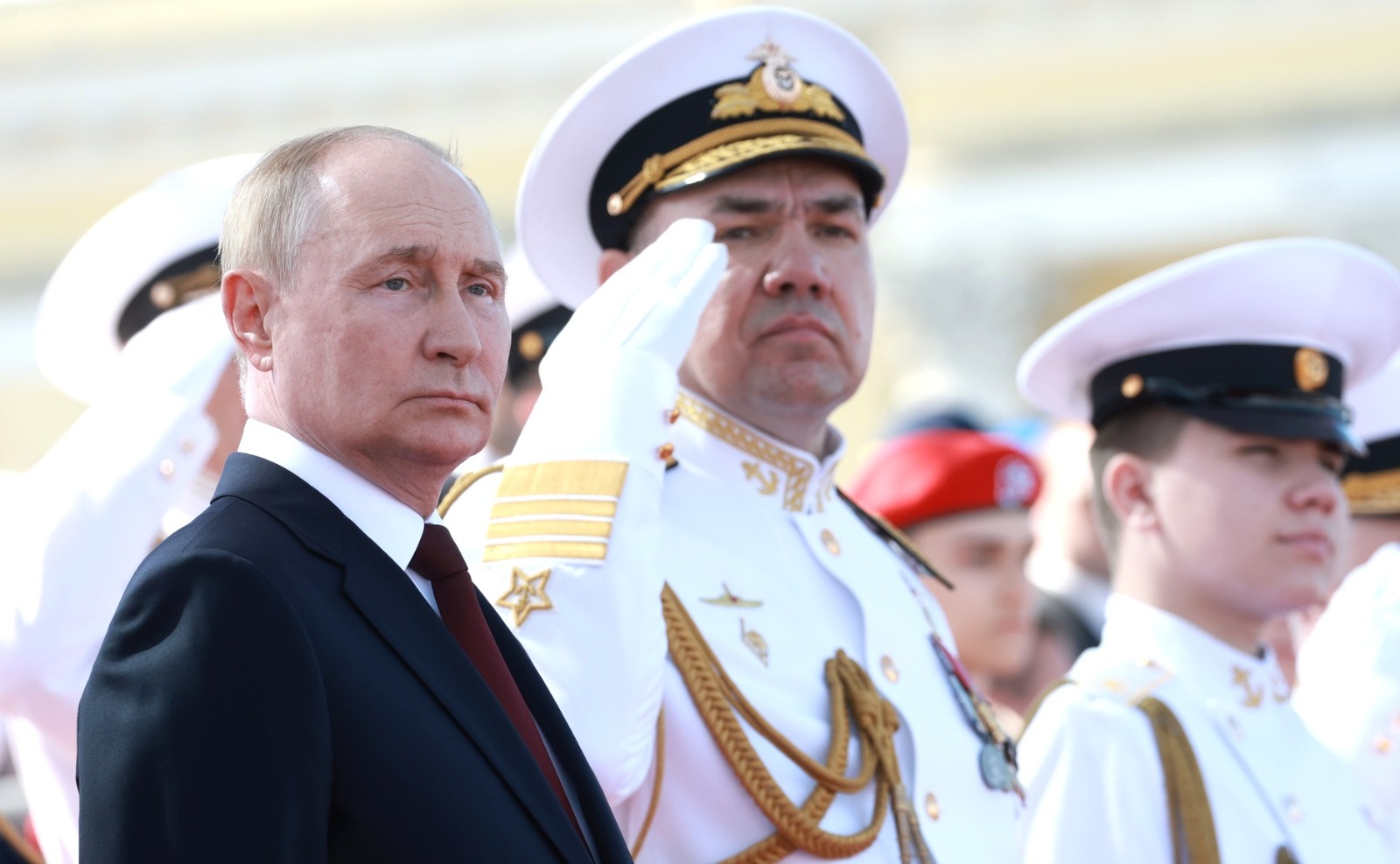In what could be construed as a potential warning to the United States, a prominent think tank monitoring the Ukraine conflict reported that Russia utilized its Navy Day to highlight its relationships with non-Western nations as part of its strategy to create an alleged coalition of countries led by Russia against the West.
This assertion was made by the Washington-based Institute for the Study of War (ISW) after Russia’s Navy Day celebrations in St. Petersburg on July 28.
The report highlighted that Russia’s Navy Day parade saw participation from delegates belonging to 31 countries.
A statement from the Russian President’s office said that delegates from Algeria, Azerbaijan, Bahrain, Brazil, Cambodia, Cameroon, China, the Republic of the Congo, Cuba, Djibouti, Egypt, Ethiopia, the Republic of Guinea, India, Indonesia, Iran, Kenya, Libya, Morocco, Mozambique, Myanmar, Namibia, Pakistan, Qatar, South Africa, Sri Lanka, Syria, Tanzania, the UAE, Venezuela, and Vietnam attended the meeting at the Admiralty.
Though many of these 31 states remain embroiled in tensions with the West, at least some have been staunch allies in the past, while others maintain cordial relationships.
According to reports, the foreign combat ships that participated in Russia’s Main Naval Parade on the Neva River included the Algerian Navy’s training ship Soummam, the Chinese guided-missile destroyer Jiaozuo, and the Indian Navy’s frigate Tabar.
To back its argument that Russia was trying to cobble an anti-Western alliance, the ISW report also said that Alexander Fomin, the deputy defense minister of Russia, met with Hu Zhongmin, the commander of the People’s Liberation Army Navy of China, to talk about naval cooperation. Additionally, Fomin held a meeting with Win Htein, the chief of Myanmar’s Navy, to deliberate on expanding naval cooperation between the two states.
In a separate development, Malaysian Foreign Minister Mohamad Hasan and Russian Foreign Minister Sergey Lavrov also agreed to increase diplomatic ties between their countries in Kuala Lumpur. The ISW report went on to say that Russia has been steadily expanding cooperation with several nations, including Venezuela, Cuba, India, and Vietnam.
In addition, the Russian Navy has spent the month engaging with friendly countries. In July alone, for instance, Russia conducted military drills with Iran in the Caspian Sea, an extensive military exercise, and joint patrols with China. Moreover, a Russian Navy flotilla also entered the Mediterranean. The Northern Fleet flotilla, led by the frigate Admiral Gorshkov, recently called at ports in the region, including in Algeria and Syria.
Presiden Russia 🇷🇺 Vladimir Putin bertemu dengan 30 pimpinan delegasi asing yg ikut serta dalam perayaan Russian Navy Day
di Admiralty building. pic.twitter.com/1vi7q0Xa1a— LuckyLucky 🇮🇩 ⚔ (@luckylucky0971) July 29, 2024
While the involvement of non-NATO countries doesn’t inherently indicate an anti-West coalition—since many maintain productive ties with the West – it does suggest that the US’s efforts to isolate Russia might not be really working.
Earlier this year, Russia’s Foreign Minister Sergei Lavrov said that the attempts made by the United States and its allies to isolate Russia were failing because the global majority was unwilling to “pull the chestnuts out of the fire” for former colonial nations.
Speaking at the online Global Conference on Multipolarity in April 2024, Russia’s top diplomat said, “It seems only natural that efforts by Washington and its satellites to reverse the course of history and force the international community to live up to a ‘rules-based world order’ have failed. I will only mention the completely failed course toward isolating Russia that the Westerners have been pursuing.” He further added, “The majority of countries inhabited by some 85% of the world’s population are reluctant to pull the chestnuts out of the fire for former colonial powers.”
The participation of more than 30 countries in Russia’s Navy Day parade showcased that while the US-led Western world and its Asian allies may have united against Russia, it was not as isolated on the global stage as Washington may have envisioned.

Putin Warned The West
Vladimir Putin, the country’s president and supreme commander in chief, observed Russia’s Navy Day and reviewed the Main Naval Parade held in St Petersburg. The President visited the parade line of warships on the Neva River roadstead on the naval motorboat Raptor with the Commander-in-Chief of the Russian Navy, Alexander Moiseyev, and Defense Minister Andrei Belousov. Over 2,500 military troops, 20 surface ships and boats, one submarine, and four sailing vessels participated in this year’s parade.
This was significant given that Russia’s Naval power has come under a scanner after recurrent attacks by Ukraine that have allegedly decimated Moscow’s Black Sea Fleet. However, the parade was used as a platform by Putin to highlight the combat readiness of the Russian Navy.
Speaking during the parade, Putin warned the United States that if Washington placed long-range missiles in Germany, Russia would place missiles of a similar design within striking reach of the West.
During a speech to sailors from Russia, China, Algeria, and India in the historic imperial city of St. Petersburg on Russian Navy Day, Putin cautioned the US that the action could trigger a missile crisis reminiscent of the Cold War.
“The flight time to targets on our territory of such missiles, which in the future may be equipped with nuclear warheads, will be about 10 minutes,” Putin said. “We will take mirror measures to deploy, taking into account the actions of the United States, its satellites in Europe, and other regions of the world.”
The statement was issued in reaction to a prior announcement from the US regarding its intention to start deploying long-range missiles and establish a new base in Germany in 2026. These moves are part of a longer-term plan that will entail the deployment of Tomahawk cruise missiles, SM-6 long-range missiles, and next-generation hypersonic weapons.
- Contact the author at sakshi.tiwari9555 (at) gmail.com
- Follow EurAsian Times on Google News